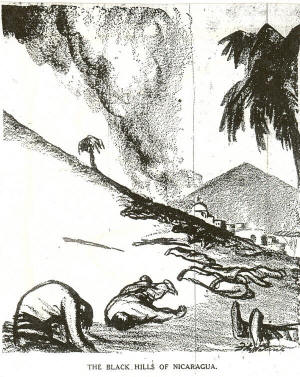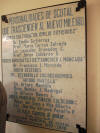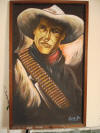|
QUICK LINKS TO PREVIOUS & NEXT PC-DOCS
27.05.19 CHAPPELL
27.06.07 SWANSON
27.06.22 RICHAL
27.07.16 HATFIELD
27.07.20 HATFIELD
27.07.28 HATFIELD
27.08.12 FLOYD
|
|
27.07.16.
Hatfield, Attack on Ocotal
|
|
P C - D O C S :
P A T R O L & C
O M B A T R E P O R T
S |
|
thru 1927 |
1928 |
1929 |
1930 |
1931 |
1932 |
1933 + |
|
1
|
2
|
3
|
4
|
5
|
6
|
7
|
8
|
9
|
10
|
11
|
12
|
T R A N
S C R I P
T I O N
|
Date: |
16 July 1927 |
|
Place: |
OCOTAL |
|
U.S. Forces engaged: |
|
|
Bandit Forces engaged: |
Five Hundred (500) |
|
C.O. U.S. Forces engaged: |
Captain G. D. HATFIELD |
|
Bandit Leaders: |
A. C. Sandino |
At 0115, 16 July, 1927, an attack on the city of OCOTAL
was launched by the forces of A.C. Sandino. The
sentry on post in front of the barracks saw a
suspicious movement in the street just beyond
the officer's quarters and went to investigate.
As he approached he was fired upon by four men
from the street corner one block west of the
officer's quarters. He returned the fire, after
which he took his battle station.
All the men were dressed and at their assigned stations
firing within three minutes from the time the
first shot was fired and were receiving fire
from all directions, and from well located
snipers in addition. The outlaws had evidently
infiltrated into the town during the early part
of the night and expected to effect a complete
surprise.
The street on which the Marine Barracks was located was
swept by machine gun fire from a position on a
hill in prolongation of the street, and it was
fire from this gun which wounded Private
Garrison.
The intersecting street between the barracks and the
officers quarters was swept by machine gun fire
from a gun located in the Jefe Politico's
office, and also by a friendly fire from a
machine gun located in the street in front of
the barracks of the Guardia Nacional, being
fired by Lieut. Bruce in an effort to silence
the enemy gun at the office of the Jefe
Politico. It was through this barrage, aided by
rifles, that the officers had to pass to join
their organizations.
The initial attack slackened at about 0300, when the
bugles sounded their assembly for
re-organization. It was at this time that
Sandino arrived from Mosonte and evidently
changed the plan of attack. Two automatic rifles
and some snipers kept up a desultory firing
until 0810, when a bearer of a flag of truce
approached with a message from Sandino and
another from Sanchez. Firing was suspended while
the truce bearer approached but all men remained
at the ready with orders to allow no shifting of
enemy troops or change of enemy dispositions
while the notes were being read and replied to.
The notes were to the effect that we had put up a brave
fight, that we would have guarantee of immunity,
and that we were known to be short of water, an
error on his part, for we had enough in
government "guarro" tanks to last two weeks;
therefore if we would throw our arms in the
streets we would not be harmed, but if we did
not surrender within sixty minutes, he (Sandino)
would fire the town and show us an amount of
rifle fire that we had not dreamed of before. [
p. 2 ] Captain Hatfield replied that, Marines
did not know how to surrender and that water or
no water we would stick it out until killed or
captured, and that firing would be resumed as
soon as the flag bearer had turned the nearest
corner.
Heavy rifle and machine gun fire continued until about
1015, when two planes arrived, circled the town
caught the messages and fired bursts of machine
gun fire.
One plane, Marine Gunner Wodarczyk, pilot, flew low
over field. The pulled up and regained altitude.
The other plane, Lt. Boyden, pilot, then chased
three mules off field with plane. he saw no
marines on the field and landed at the airdrome.
Two natives came running from bushes beside
field to the plane. They appeared nervous and
said that Sandino was in OCOTAL. They indicated
that there had been shooting. When questioned,
they said the Marines were still in OCOTAL. They
then ran to the bushes. The ship took off
immediately. Observed panel message laid in
street of town, "SANDINO ATTACKING". In the
meanwhile the other plane piloted by Marine
Gunner Wodarczyk attacked a point at the river
one mile S.E. of town. The other plane dived in
three times attacking with the front gun. Got
off 230 shots. After M.G. Wodarczyk had fired
all of his ammunition, 350 rounds, he headed for
home. The other plane then attacked five times
with rear and front guns, then headed for
Managua.
At 1315 a formation of five planes made a formation
flight to OCOTAL to aid Marines besieged in that
place by the bandit Sandino. Each plane carried
17 pound fragmentation bombs and two guns with
800 rounds of ammunition.
The planes arrived in OCOTAL at 1440 -- reconnoitered
the outskirts of town. On the southeastern edge
of town about fifty (50) saddle horses with the
men at a house nearby were observed. From the
reconnaissance it appeared that the south and
southeastern border of the town was occupied by
Sandino's troops. The planes circled in column
and dove in turn on Sandino's troops, attacking
with bombs and gun fire. Several direct hits
were observed and the effect was immediate, the
men streaming away from the houses and throwing
away their arms as they ran. After the planes
had bombed these troops the attack was followed
by a further attack with fixed and free machine
guns completing the rout. The planes repeatedly
circled the town and fired on numerous groups of
bandits that were fleeing. Captain Hatfield had
his headquarters in the center of the town, with
the detachment identification panel laid out in
the street in front of the house.
At 1515 the planes having released all of their bombs
the assembly signal was given and the planes
returned to Managua.
The bombing and machine gun attack caused
numerous casualties to Sandino's force. The
moral effect was exceedingly great, men throwing
down their arms and running in all directions
away from the town towards wooded country. The
machine gun attack which followed completed
their defeat.
RG127/206
|
T R A D
U C I D O
|
Fecha: |
16 de Julio de 1927 |
|
Lugar: |
OCOTAL |
|
Las fuerzas participantes de los
EE.UU.: |
|
|
Las fuerzas participantes de los
bandoleros: |
Quinientos (500) |
|
Comandante en Jefe participante
de las fuerzas de los EE.UU.: |
Capitán G. D. HATFIELD |
|
Líderes Bandoleros: |
A. C. Sandino |
A las
01.15h, el 16 de julio de 1927, un
ataque contra la ciudad de Ocotal
fue lanzada por las fuerzas de A. C.
Sandino. El centinela en frente de
los cuarteles vio un movimiento
sospechoso en la calle un poco más
allá de los cuartos del oficial y se
fue a investigar. Cuando se acercó
fue atacado a balazos por cuatro
hombres de la esquina de la calle
una cuadra al oeste del cuarto del
oficial. Regresó el fuego, tras lo
cual tomó su estación de batalla.
Todos los
hombres estaban vestidos y en sus
estaciones asignadas disparando
dentro de los tres minutos desde el
momento en que el primer tiro fue
disparado y estaban recibiendo fuego
desde todas las direcciones, y de
los bien ubicado francotiradores
además. Evidentemente los proscritos
habían infiltrado en la ciudad
durante la primera parte de la noche
y se esperaban lograr una sorpresa
completa.
La calle en
la que los cuarteles de la
Infantería de Marina se encuentra
fue barrida por fuego de
ametralladora desde una posición en
una colina de prolongación de la
calle, y fue el fuego de esta arma
que hirió al soldado Garrison.
La calle
intersectando entre los cuarteles y
los cuartos de los oficiales fue
barrida por fuego de ametralladora
desde la oficina del Jefe Político,
y también por fuego amistoso de una
ametralladora situada en la calle
frente a los cuarteles de la Guardia
Nacional, disparado por el Teniente
Bruce en un esfuerzo para silenciar
la artillería del enemigo en la
oficina del Jefe Político. Fue a
través de esta barrera, con la ayuda
de fusiles, que los oficiales tenían
que pasar a juntarse con sus
organizaciones.
El ataque
inicial se había moderado alrededor
de las 03.00h, cuando los clarines
sonaba su asamblea de
re-organización. Fue en ese momento
que Sandino llegó de Mosonte y
evidentemente cambió el plan de
ataque. Dos fusiles automáticos y
algunos francotiradores mantenían un
improvisado fuego hasta las 08.10h,
cuando el portador de una bandera
blanca se acercó con un mensaje de
Sandino y otro de Sánchez. Fuego se
suspendió mientras al portador de
tregua se acercó sin embargo todos
los hombres se mantuvieron en la
lista con ordenes de no permitir el
desplazamiento de las tropas
enemigas o cambio de disposiciones
del enemigo mientras que las notas
fueron leídas y respondidas.
Las notas
eran en el sentido de que había sido
un valiente lucha, que tendríamos
garantía de la inmunidad, y que
fuimos conocidos por ser corto de
agua - un error por su parte, ya que
tuvimos suficiente en los tanques de
"guarro" del gobierno para durar dos
semanas; por lo tanto, si tiraríamos
nuestras armas en las calles, no
estaríamos perjudicados, pero si no
nos rendimos dentro de un plazo
máximo de sesenta minutos, él
(Sandino) se dispararía la ciudad y
mostrarnos una cantidad de disparos
de fusil que no habíamos soñado
antes. [ Pág. 2 ] Capitán Hatfield
respondió que los infantes no saben
cómo rendirse, y que agua o no agua,
aguantaríamos hasta la muerte o ser
capturados, y que los disparos
reanudarían en cuanto el portador de
la bandera hubiera doblado la
esquina más cercana.
Fuego
pesado de rifle y de ametralladora
continuó hasta las 10.15h, cuando
dos aviones llegaron, sobrevolaron
la ciudad, captaron los mensajes y
dispararon ráfagas de ametralladora.
Un avión,
artillero infante Wodarczyk, piloto,
voló a baja altura sobre terreno. Y
luego tiró la palanca hacia arriba y
recuperó altitud. Después el otro
avión, el Teniente Boyden, piloto,
echó tres mulas fuera del campo con
el avión. No vio a ningunos infantes
en el campo y aterrizó en el
aeródromo. Dos nativos vinieron
corriendo desde los arbustos junto
al campo hacia el avión. Parecían
nerviosos y dijeron que Sandino
estaba en Ocotal. Indicaron que
había habido tiroteo. Cuando se les
preguntó, dijeron que los infantes
estaban aún en Ocotal. Después se
fueron corriendo a los arbustos. El
avión despegó inmediatamente. Se
observó el mensaje de panel sentado
en la calle de la ciudad, "SANDINO
ATACANDO". Mientras tanto, el otro
avión piloteado por artillero marina
Wodarczyk atacó a un punto en el río
una milla sureste de la ciudad. El
otro avión se sumergió tres veces
atacando con la pistola delantera.
Tiró 230 disparos. Después de que M.
G. Wodarczyk había disparado todas
sus municiones, 350 rondas, se
dirigió a casa. El otro avión, atacó
cinco veces con pistolas delanteras
y traseras, y después se fue para
Managua.
A las
13.15h una formación de cinco
aviones hizo un vuelo en formación
hasta Ocotal para ayudar a los
infantes en ese lugar asediados por
el bandido Sandino. Cada avión
llevaba bombas de fragmentación de
17 libras y dos pistolas con 800
rondas de municiones.
Los aviones
llegaron en Ocotal a las 14.40h --
reconoció las afueras de la ciudad.
En el borde sureste de la ciudad se
observaron a unos cincuenta (50)
caballos de montar con los hombres
en una casa cercana. Del
reconocimiento parecía que los
bordes del sur y sureste de la
ciudad estaban ocupados por las
tropas de Sandino. Los aviones
circularon en columna y sumergieron
a su vez a atacar con bombas y
disparos a las tropas de Sandino.
Varios impactos directos fueron
observados y el efecto fue
inmediato: los hombres saliendo en
tropel de las casas y arrojando sus
armas mientras que se corrían.
Después de que los aviones habían
bombardeado estas tropas el ataque
fue seguido por un nuevo ataque con
ametralladoras fijas y sueltas para
completar la ruta. Los aviones
sobrevolaron la ciudad varias veces
y dispararon sobre numerosos grupos
de bandidos huyéndose. El Capitán
Hatfield tenía su sede en el centro
de la ciudad, con el panel de
identificación del destacamento
establecido en la calle en frente de
la casa.
A las 15.15h los aviones, después de
haber lanzado todas sus bombas, se
dio la señal de montaje y los
aviones regresaron a Managua.
El bombardeo y ataque de
ametralladora causaron numerosas
víctimas en las fuerzas de Sandino.
El efecto moral era muy grande: los
hombres arrojando sus armas y
corriendo por todas las direcciones
de la ciudad hacia los bosques. El
ataque de ametralladora que siguió
completó su derrota.
Gracias a Linda Pudder por su traducción de este
informe.
RG127/206
|
|
|
Summary & Notes
 •
First of several PC-Docs & other reports on
first military engagement between Marines &
EDSN. •
First of several PC-Docs & other reports on
first military engagement between Marines &
EDSN.
•
EDSN attack on Marine-Guardia garrison at Ocotal
made headlines around the world, as did the
slaughter of upwards of 300 rebels in aviators'
counterattacks.
•
Military historians consider this the first
instance in history in which ground forces (led
by Capt. Hatfield) directed an aerial assault
against opposing ground forces.
•
Events leading up to the Sandinista attack & the
battle itself receive extensive treatment in the
literature (e.g., Neill Macaulay, The
Sandino Affair, chap. 4).
•
Ocotal events also comprise an important element
in Sandinista historical memory, e.g., IES
testimonies.
•
Reaction of world press to these events
discussed in my article on the air war (International
History Review, Sept. 2007)
and on the
Air-Toons page.
•
lllustration at right: "The Black Hills of Nicaragua,"
St. Louis Post-Dispatch, 25 July 1927.
•
Today the former Marine barracks bordering the
city plaza in Ocotal is a museum, "La Casa de
Cultura Augusto C. Sandino" and maintained by
the Alcaldía de Ocotal; some photos appear
below. Notably, the plaque describing the
attack is historically inaccurate; the US
Marines didn't start occupying Ocotal until
early June 1927, not 1926 as indicated on the
plaque (4th image below). Photos by
Michael J. Schroeder, Feb. 2012; click on
thumbnails to view full photos:
 |
 |
 |
 |
 |
|
Exterior of the "Casa de Cultura Augusto
C. Sandino" in Ocotal
|
Interior plaque: "Personalidades
de Ocotal que transcienden al nuevo
milenio"
|
Painting of A. C. Sandino
|
Plaque describing the attack on
Ocotal (with incorrect date & spelling
of Hatfield's name, along with other
inaccuracies)
|
Looking
out from the 2nd floor balcony toward
the central plaza
|
Resumen y Notas:
•
El primero de varios PC-Docs & otros informes
del primer enfrentamiento militar entre los
Marinos y EDSN.
•
El ataque por EDSN contra la guarnición de los
Marinos-Guardia en El Ocotal fue noticia en todo
el mundo, al igual que el sacrificio de más de
300 rebeldes en los contragolpes de los
aviadores.
•
Historiadores militares consideran que este es
el primer caso en la historia en que las fuerzas
de tierra (dirigidos por el Capitán Hatfield)
dirigieron un ataque aéreo contra las fuerzas
opuestas de tierra.
•
Los hechos que condujeron el ataque Sandinista y
la batalla misma reciben un amplio tratamiento
en la literatura (p. ej., Neill Macaulay, El
Sandino Affair, cap. 4).
•
los eventos de Ocotal son también un elemento
importante de memoria histórica Sandinista, p.
ej., testimonios IES.
•
Reacción de prensa mundial de estos eventos en
mi artículo sobre la guerra aérea
(International
History Review, Sept. 2007)
y en la pagina
Air-Toons page.
•
ilustración arriba: "Los Montes Negros de
Nicaragua", St. Louis Post-Dispatch ,
25 de julio 1927.
•
En la actualidad los ex-cuarteles de los
infantes de Marina bordeando la plaza de la
ciudad de Ocotal es un museo, "La Casa de la
Cultura Augusto C. Sandino" y está mantenido por
la Alcaldía de Ocotal; aparecen unas fotos
arriba. En particular, la placa que
describe el ataque es históricamente inexacto,
la Infantería de Marina norteamericana no se
iniciaron la ocupación de Ocotal hasta los
principios de junio 1927, no 1926, como se
indica en la placa (4ª imagen arriba).
Fotos de Michael J. Schroeder, Febrero de 2012;
haga clic en las miniaturas para ver las fotos.
|
|
P C - D O C S :
P A T R O L & C
O M B A T R E P O R T
S |
|
thru 1927 |
1928 |
1929 |
1930 |
1931 |
1932 |
1933 + |
|
1
|
2
|
3
|
4
|
5
|
6
|
7
|
8
|
9
|
10
|
11
|
12
|
TOP OF PAGE
|
|